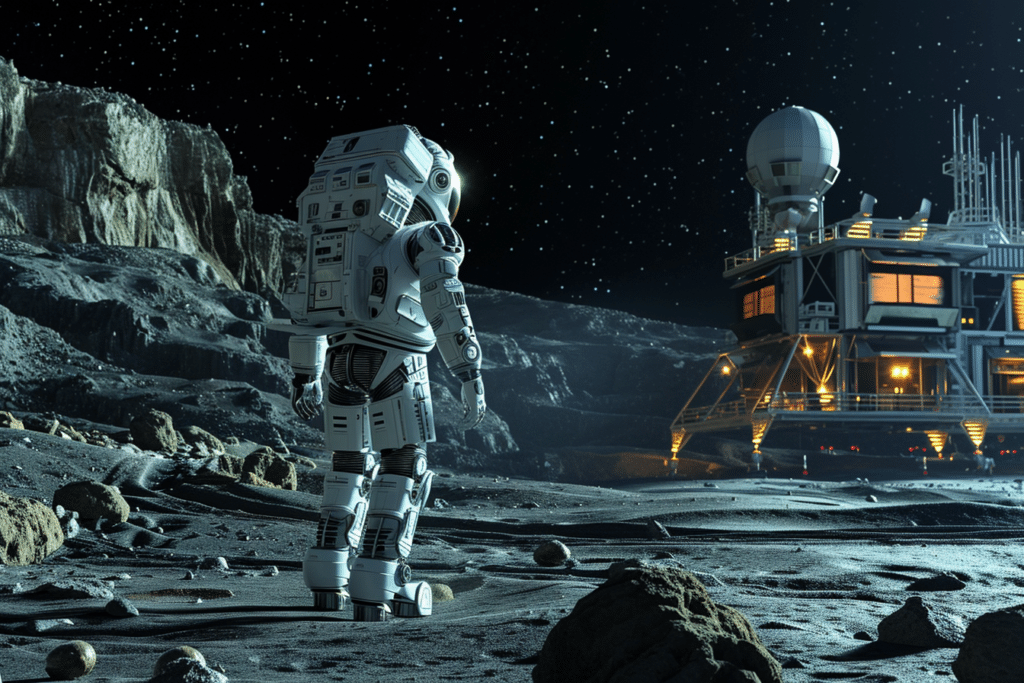
To explore the Moon and Mars, NASA wants to send humanoid robots like this one from Texas-based Apptronik. These robots could support human astronauts, explore dangerous areas, build shelters and factories, or even act as avatars for operators back on Earth. Find out more about this crazy project!
Send humans in space is the best way to explore other planets. However, this requires considerable training, impeccable health and colossal resources.
Even with meticulous preparation, many dangers threaten astronauts during the journey and once there. To overcome these limitations, NASA believes it has found the ideal alternative: humanoid robots..
The famous American space agency a partnership with a robotics company called Apptronik. The goal? Send robots into orbit or even to other planets to assist astronauts in their work.
Apptronik Apollo: the robot that will help NASA astronauts
For several years nowApptronik collaborates with NASA as part of the Small Business Innovation Research (SBIR) program to improve its Apollo robot. This humanoid was originally designed for terrestrial tasks such as logistics, manufacturing or home assistance.
NASA, however, is interested in this machine with a view tomaking it an assistant for astronauts living and working in orbit, but also on the Moon or even Mars.
In the near future such robots could even be controlled remotely by operators remaining on Earth to act as their avatars. L’space exploration would then become similar to a video game.
Why choose Apollo over one of its many competitors? It turns out that Apptronik has strongly emphasized modularity in design of its robot.
With a size of 1m73 for 73 kilogramsThe machine has a four-hour autonomy with a replaceable battery, and can carry loads of 25 kilograms.
This is what makes it a humanoid suitable for stores, warehouses, etc.factories, but also potentially the conquest of space…
In the future, its flexibility could make it possible to reprogramming or physical customization. Already today, it is possible to adjust one’s dexterity level or equip it with different tools.
Astronauts replaced by humanoid robots?
In order to accelerate this development, NASA provides its own expertise the fruit of decades of work in robotics. It helps Apollo in areas such as robotic mobility and software design for safer human-robot interactions.
As Shaun Azimi, director of the robotics team at NASA’s Johnson Space Center, explains, ” by applying NASA’s expertise in mobile robots to commercial projects, together we are able to stimulate innovation in this important field “.
In his words, “ we are proud to see the results of our efforts in robotic technology that will benefit the American economy and assist humans to work safely and productively on Earth and potentially in space exploration as well. “.
Clearlysending a robot rather than a human to the Moon or Mars would be safer and more efficient. In these hostile environments, a machine is much more likely to survive.
Already today landers, drones and other rovers sent into space are already forms of robots. However, a general-purpose humanoid robot would be capable of replacing human astronauts outright.
However, it would have to be reprogrammed whenever a new task requires itincluding those that its designers did not think of when building it.
Valkyrie: the humanoid robot created by NASA
In addition to its partnership with Apptronik and other companies, NASA has also created its own Valkyrie robot measuring 188 centimetres and weighing 136 kilograms.
Already tested at the Johnson Space Center in Houston, Texasthis humanoid is designed to operate even in degraded or damaged environments.
Initially, it will be deployed in the areas affected by natural disasters on Earth. Later, however, it could be sent into space.
Its role could be to take on risky tasks such as cleaning solar panels or inspecting malfunctioning equipment on the outside of spacecraft.
Here again, the aim would be to enable astronauts to focus on exploration and discovery. Sound autonomy could reach 22 hours per daythanks to a replaceable battery.
Shelter construction, lunar factory management…

Such machines could perform tasks such as building shelters or taking rock sampleswould allow astronauts and Earth-based operators to concentrate on other scientific tasks.
In addition, these robots could help to manage and maintain mining infrastructures or manufacturing facilities on other planets to process resources on site. The cost of these missions for NASA would be drastically reduced.
Making a concrete base directly on the moon using the materials would be much cheaper than sending it from Earth.
Thus, incorporating robots into future NASA Artemis missions could be the key to creating a lasting human presence on the Moon and then on Mars.
NASA and robotics: numerous projects and spin-offs on Earth

This is what explains why the space agency is so interested in in robotics. In addition to Apptronik’s Apollo, NASA’s Jet Propulsion Laboratory also conducts the CoSTAR project an initiative focused on adapting commercially available robots to navigate beneath the surface of other planets.
Likewise, the Dragonfly mission scheduled to begin in 2027 will send an autonomous rotorcraft to Saturn’s moon Titan in 2034. The robot will fly around the moon at a speed far higher than the best existing rovers.
All like the Apollo program of the 1960s and 1970s allowed the American semiconductor industry to take off, NASA may well be able to do the same. help the robotics industry to develop with major economic and technological spin-offs on Earth…
Alongside the Moon and Mars, the humanoid robots could gradually invade the blue planet and support humanity in all its tedious tasks. Elon Musk expects every household to have its own robot capable of doing all the chores by 2050.
According to him, humanoids like the Tesla Optimus will be soon outnumber humans thanks to a cost lower than that of a car. To find out all you need to know about this coming revolution, click here to read our full report on humanoid robots!
Our blog is powered by readers. When you purchase via links on our site, we may earn an affiliate commission.